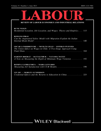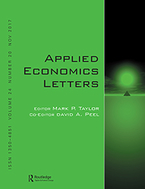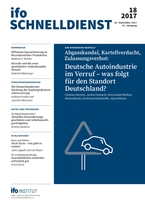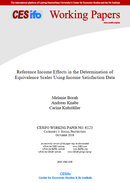Aktuelle Publikationen
LABOUR: "When Protection Puts You in Jeopardy -- How Removing Small-Business Clauses Affects Employment Duration" (Lücke)
Neue Publikation von Christine Lücke:
|
In a 2004 reform, Germany exempted small firms from dismissal protection. This paper estimates the effects of dismissal protection on the risk of leaving the establishment, taking advantage of the fact that workers employed before the amendment maintained their previous dismissal protection. Utilizing administrative linked employeremployee data, the results hint at a higher risk during the first 6 months in a job and a lower risk thereafter, if dismissal protection is provided. The estimated survivor curves suggest that even after 5 years the protecting effect of dismissal protection did not compensate the initially adverse effect during the first 6 months of tenure.
Finden Sie die Publikation hier. |
 |
Applied Economics Letters: "There and back again - estimating equivalence scales with measurement error" (Borah, Knabe)
Neue Publikation von Melanie Borah und Andreas Knabe:
|
Using income satisfaction data from the German Socio-Economic Panel, we find large differences in the equivalence weight of a partner when it is being estimated by direct and reverse regressions. We argue that neither of the two models will produce consistent estimates when there is stochastic error in satisfaction and measurement error in incomes. We propose a correction of mismeasured incomes using a constructed alternative income measure. The corrected results are relatively close to those obtained from direct regression. We do not find evidence that previous studies, using the direct regression method, severely suffer from measurement error in incomes.
Finden Sie die Publikation hier. |
 |
ifo Schnelldienst: "Die Deutschlandrente: Ein Konzept zur Stärkung der kapitalgedeckten Altersvorsorge"
Neue Publikation von Andreas Knabe und Joachim Weimann:
|
Andreas Knabe und Joachim Weimann haben gemeinsam mit der Hessischen Landesregierung einen Reformvorschlag zur Stärkung der kapitalgedeckten Altersvorsorge entwickelt ("Deutschland-Rente"). In einem neuen Aufsatz, der gerade im ifo Schnelldienst erschienen ist, stellen sie den Vorschlag ausführlich dar.
Finden Sie den Aufsatz hier. |
 |
CESifo Working Papers: "Reference Income Effects in the Determination of Equivalence Scales Using Income Satisfaction Data"
Neues Diskussionspapier von Melanie Borah, Andreas Knabe und Carina Kuhställer:
|
In diesem Diskussionspapier untersuchen die Autoren die Bedeutung von Vergleichseffekten bei der Schätzung von Äquivalenzskalen mithilfe von Einkommenszufriedenheitsdaten. Die Studie zeigt, dass eine Trennung von Bedarfs- und Vergleichseffekten mögliche Verzerrungen in den geschätzten Äquivalenzskalen verhindern kann, aufgrund derer der Bedarf zusätzlicher Erwachsener überschätzt und der von Kindern unterschätzt wird. Im Rahmen einer empirischen Analyse von SOEP-Daten bestätigt sich dieses Ergebnis, da hier die Berücksichtigung von Einkommensvergleichen zu einer Angleichung der Äquivalenzgewichte von zusätzlichen Erwachsenen und Kindern führt.
Finden Sie das Diskussionspapier hier. |
 |
Economics Bulletin: "Reconsidering the interrelated dynamics of unemployment and low-wage employment in Great Britain"
Neues Diskussionspapier von Alexander Plum:
|
Stewart (2007, JAE) finds that being employed at low wages (compared to higher wages) increases the risk of future unemployment. The risk of unemployment does not differ significantly between current low-wage employment and current unemployment. The author concludes that 'in terms of future employment prospects, low wages are closer to unemployment than to higher-paid jobs' (p. 529). Alexander Plum shows in this paper that the result depends strongly on the thershold used to distinguish between high and low wages: applying this widely used OECD (1997) definition of low-wages substantially changes the findings of Steward (2007). With this threshold, Plum finds that low wages are helpful for significantly reducing the risk of future unemployment compared to unemployment. Moreover, the categorization of the unemployed, the included variables with reference to the educational background, the age and the age restrictions imposed on the sample and switching from gross hourly wages in nominal terms to real terms have an impact on the findings
Finden Sie das Diskussionspapier hier. |
 |